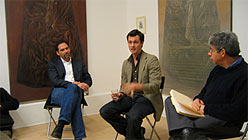I thought I was too old for bedtime stories. For enchanted forests and little boys who tell tales no one believes. But then I heard such a story, last month, in a quiet San Francisco art gallery, in a white walled room covered with paintings of gnarled wood and golden fountains. I was rapt, waiting to hear how it would turn out. The story ended in the very gallery where I sat, in a room full of people, as artist Neil LeDoux explained the genesis of the work hanging in the exhibit titled The Fountain of Giant Teardrops, on display through February 28th at the Silverman Gallery.
LeDoux was telling Berkeley Art Museum director Larry Rinder the story of the day when, as a child, he discovered a mystical fountain deep in the Louisiana woods. He ran home and told his family, but no one believed him. He brought people back to the spot, but all they saw were trees. LeDoux, an undergraduate student at California College of the Arts, didn’t talk about the fountain again for years. And he certainly didn’t make drawings about it. Until now. “If not at an art college in San Francisco, where else would you address it?” he asked. “In San Francisco, you can tell someone a story like this and they don’t think you’re crazy.” The room full of people, all listening intently, seemed to prove his point.
LeDoux and Rinder’s conversation covered the artist’s influences (Duchamp’s Fountain was a major one); working process (he produced this body of work in a consumed frenzy, putting in 15 to 18 hour days over a period of two weeks); and the fountains’ hermaphroditic qualities (“It’s a phallus made of vaginas,” Rinder observed). What they didn’t cover was why LeDoux’s story is engrossing, and why the art it inspired deserves attention. No longer lulled by fairytale stories of boys chasing trees, but awake and alert, I want to address those things here.
Most would agree that art relies on a larger narrative, a conceptual back-story, for its meaning and import. Even when not intentionally symbolic, a painting is always more than paint on a canvas. It is a signifier of ideas, cultural values, and often, the artist’s own biography. I think much of the general public’s frustration toward contemporary art comes from an awareness of this meaning’s existence coupled with an inability to decipher it.
Enter LeDoux. Rarely do artists offer such a neatly packaged, easily communicated story as he. Rather than vague allusions, LeDoux presents a cohesive narrative that satisfies our desire to “understand” his art. The story itself is a good one. Against the backdrop of the lush and mysterious woods of the American south, the artist acts as both visionary and outsider. The tale is particularly pleasing to San Francisco ears, as LeDoux’s westward migration and subsequent self-actualization satisfy our collective superiority complex: Of course the artist had to come to northern California to realize the validity of his childhood visions and learn to express his artistic truth. Doesn’t everybody?


